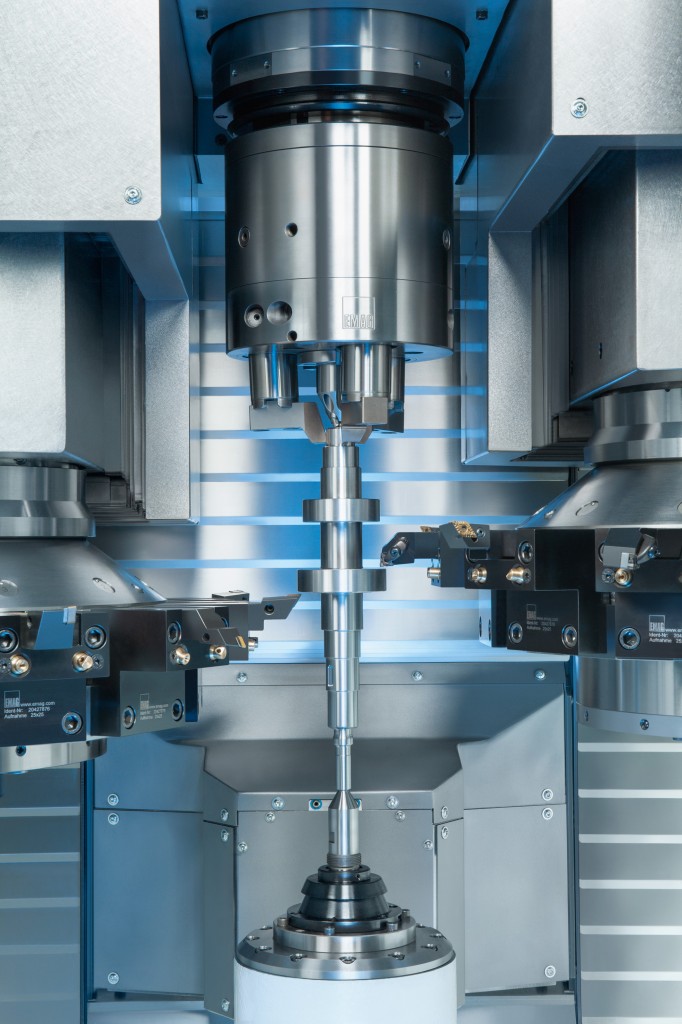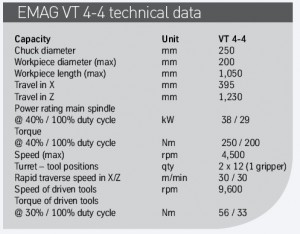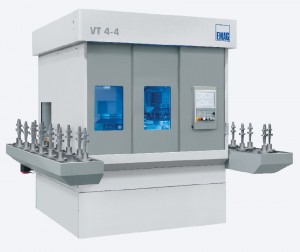

 Modern vertical turning technology can deliver productivity advances that translate into increased profitability, writes Oliver Hagenlocher, head of marketing, EMAG
Modern vertical turning technology can deliver productivity advances that translate into increased profitability, writes Oliver Hagenlocher, head of marketing, EMAG
The gearbox production market is growing and competition is intensifying, according to a study by Roland-Berger which concludes that a market growth rate of approximately 6% within the next two years is achievable. However, the supply industry is facing increased competition from new players in emerging markets. What can be done to address this?
First and foremost, a closer look at the profitability of production sites might help. Component production must become faster, deliver greater precision and show a greater degree of economic viability. What the relevant production solutions could be like becomes apparent with a closer look at the new VT 4-4 vertical turning machine, developed by the turning specialists at EMAG. This machine delivers top efficiency levels in high-volume gearbox production.
For a number of reasons, the production of drive and gear shafts represents a very specific key task in the manufacture of automobiles. For one, many of their components are of a very detailed and highly complex geometry, upon which so much depends. For instance, high-precision gearings ensure hugely effective torque transmission within the gearbox, while high-precision shoulders and grooves guarantee the safe connectivity of components.
The efficiency of a powertrain as a whole depends to a large degree on the functionality of its shafts. These highly complex components must be produced in their millions – quickly and with the greatest precision. Upon completion of the central turning work, the shaft should ideally display a geometry that is as close to its final contour as possible. The tolerances that production planners are looking for in this respect lie in the micrometre range.
 So how can these high-performance requirements be met? The turning specialists at EMAG have focused their attention on this question for decades, and the company’s machine builders development team now creates tailor-made, highly innovative manufacturing solutions for the production of shaft-type components. Their vertical four-axis shaft turning machine VT 4-4, in particular, follows this tradition. It opens up new possibilities in the machining of components with a maximum length of 1,050mm and a maximum diameter of 200mm.
So how can these high-performance requirements be met? The turning specialists at EMAG have focused their attention on this question for decades, and the company’s machine builders development team now creates tailor-made, highly innovative manufacturing solutions for the production of shaft-type components. Their vertical four-axis shaft turning machine VT 4-4, in particular, follows this tradition. It opens up new possibilities in the machining of components with a maximum length of 1,050mm and a maximum diameter of 200mm.
The first point to note is that the various phases of the process take place simultaneously. Machining is carried out in four axes at a maximum speed of 4,500rpm. The process employs two turrets with 12 tool stations, each one equipped with turning tools or driven tools (with one station reserved for the gripper).
Secondly, it is automated. Workpiece grippers move raw parts to the machining area and remove the finished components. In other words, one gripper inserts a new raw part into the machine at the same time as the other gripper removes the finished component from it.
A reduction in unit costs
According to Guido Hegener, managing director of EMAG Maschinenfabrik, “this automation principle offers a great step up in performance in the production of shafts – especially in an environment that deals with large component volumes.” He continues: “Owing to the fast workpiece changeovers and the powerful machining in four axes, cycle times are very short. In combination with a simple automation system, this ensures that the unit costs are kept to a minimum. This is of great benefit to the user.”
In its standard execution, the machine is equipped with two space-saving, recirculating conveyors that accommodate up to 28 raw parts and 28 finished components respectively. Transfer and turnover units or robots ensure that a number of VT machines can be linked up cost-effectively and with great ease.

Of particular importance to the development engineers at EMAG is the quality of the components produced. For this purpose, the machine base is made of the polymer concrete Mineralit. It carries all technology modules: the powerful workspindle, the turrets and the tailstock. Its rigid, vibration-resistant construction guarantees an equally stable turning process that ensures high-quality surfaces and highly accurate geometries. EMAG’s typical vertical alignment of the workpiece also ensures constant process integrity. This is because the unhindered chip flow it offers prevents the accumulation of chips in the machining area.
“Last, but by no means least, we have also attached great importance to the ease of operation of these machines“, emphasises Hegener. “After all, the human factor is a very important one when it comes to productivity. We want to make it as simple as possible for the operator.” To achieve this, all relevant components – from electrics to hydraulics, plus the cooling system – are very easy to access, with the user interface being of an intuitive, clearly laid-out design.
A wide range of possibilities

In summary, EMAG’s machining solution offers short cycle times, a high degree of flexibility and a small footprint. So how do the experts rate the chances of success for their new machine concept? “We are extremely optimistic”, declares Hegener. “With its very attractive price–performance ratio, the VT 4-4 ingeniously complements our vertical-shaft turning programme. It is the reason why we believe our chances in the marketplace to be excellent.”
































